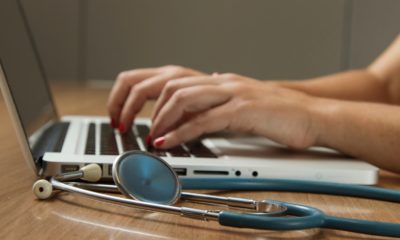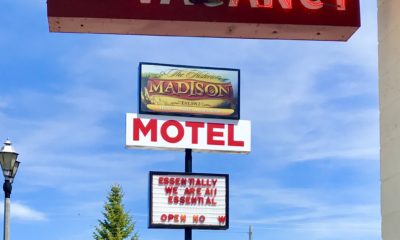Uncategorized
Community Health Partners prove good fit for Southwest Montana
Published
13 years agoon
Posted By
Admin
By Taylor Anderson
Lander Cooney’s career, like many others in lowincome
health, started in teaching. After spending a
few years in the field, Cooney began picking up on
trends of kids struggling in the classroom who also
had troubled lives.
She noticed people who had poor situations at home
often had poor results in school and bad health. She
followed studies showing that poverty correlates
with obesity and other unhealthy behavior, and
started working from there.
That’s how Cooney landed at the doorstep of the
Community Health Partners five years ago, where
she is now CEO. The low-income clinic had existed
in Livingston since 1998, when Laurie Francis, an
emergency room nurse, saw an increase in uninsured
people coming to the ER when an insured
person might go to a clinic.
That realization prompted Francis to band together
three or four staff to start the early version of the
CHP, offered two nights a week at the hospital. Each
year since then CHP has seen its annual patient
numbers increase. Over the next decade, they
established clinics in Livingston, Bozeman and
Belgrade, and in 2010 added one in West Yellowstone.
During Cooney’s five years as director of the Livingston
clinic, and now eight months as CEO, the
group has continued to expand its presence in the
community and meet the vast need in Southwest
Montana, adding dental and behavioral health
services in some clinics.
CHP reported that in 2009 it treated upwards of
8,800 patients, a number that will likely boom
with the West Yellowstone office and as services
at existing locations expand.
The partners’ board consists of 50 percent of its
own patients, a surefire way to reach the community.
The clinics rely heavily on federal grants, which
made up 47 percent of support in 2010. Patients’
payments cover 36 percent of the budget, and
the state accounts for 11 percent. The remaining
funding comes from donations.
The group, along with the 14 other community
health centers in Montana, received funding
from the federal stimulus package to help with an
increase of patients during the recession.
As of January 2011, $679,284 in
stimulus money was spread across the
14 similar low-income health clinics.
In turn, they saw an increase of 26,631
patients, which reached far past their
goal of 5,000. Over 62 percent of these
new patients were uninsured.
“There is great potential for Montana’s uninsured
population to become insured through an expanded
Medicaid program or through the voucher
system that would allow low income Montanans
to purchase insurance through state exchanges,”
Cooney said.
Though the group has received fairly ample funding,
Cooney and staff watched the 2011 Montana
Legislature challenge several provisions of health
care reform. Although this year’s legislation cut
funding for some health care services from the
state budget, Cooney remains “cautiously optimistic
that the federal legislation will lead to improved
access to healthcare for low income and uninsured
Montanans.”
There are about 1300 similar health clinics nationwide,
which best operate in rural and intercity
areas, Cooney said. These areas benefit from the
low costs of the clinics, which makes Southwest
Montana a good fit.
Cooney believes in improving the quality of lives
of anyone seeking help, and the clinics reflect that.
“It’s not just about providing access to health
care, but ‘What can we do to make patients
healthier out of poverty?’” Cooney asked.
She also touts the fact that the clinics are open to and
utilized by everybody, even the insured. Cooney
and staff also encourage health literacy, citing that
patients who don’t understand a doctor’s orders are
virtually helpless.
“An old school doctor says what to do and for patients
to do just that, but that doesn’t always work,”
Cooney said.
CHP acts as a health, dental, pharmaceutical and
psychological help center for its patients, as well as
an educational program for visitors seeking a GED. In
2009/2010, 37 people across the age spectrum earned
their GED from CHP; 39 earned it in 2010/2011,
exceeding the 33-per-year goal.
Since joining the clinic, Cooney has studied
trends and adapted her approach to providing
health care to the community. She compares data
to ensure efficiency, and hangs graphs in the
hallways of CHP’s Livingston clinic for workers
to study.
The group is “about creating partnerships in
community around health,” Cooney said. “We’re
not going to try and do it all, we’ll partner with
another clinic” to ensure the community has access
to the best health possible.
After all, “quality improvement equals a better
world.”
Upcoming Events
november, 2024
Event Type :
All
All
Arts
Education
Music
Other
Sports
Event Details
Spanish Classes with World Language InitiativeThese unique, no cost Spanish classes are made possible by the contribution of Yellowstone Club
more
Event Details
Spanish Classes with World Language InitiativeThese unique, no cost Spanish classes are made possible by the contribution of Yellowstone Club Community Foundation (YCCF) and Moonlight Community Foundation (MCF). This class will focus on building a lifelong affinity for world languages and cultures through dynamic and immersive Communicative Language teaching models.
Beginner Class – Mondays and Wednesdays from 5:30-6:30 pm
Intermediate Class – Mondays and Wednesdays from 6:45- 7:45 pm
- Classes begin Oct.7, 2024 and run for 6 weeks
- Class size is limited to 12 students
- Classes are held in Big Sky at the Big Sky Medical Center in the Community Room
For more information or to register follow the link below or at info@wlimt.org.
Time
October 28 (Monday) 5:30 pm - December 4 (Wednesday) 7:45 pm
Location
Big Sky Medical Center - Community Room (2nd Floor)
Big Sky Medical Center - Community Room (2nd Floor)
Event Details
Spanish Classes with World Language InitiativeThese unique, no cost Spanish classes are made possible by the contribution of Yellowstone Club
more
Event Details
Spanish Classes with World Language InitiativeThese unique, no cost Spanish classes are made possible by the contribution of Yellowstone Club Community Foundation (YCCF) and Moonlight Community Foundation (MCF). This class will focus on building a lifelong affinity for world languages and cultures through dynamic and immersive Communicative Language teaching models.
Beginner Class – Mondays and Wednesdays from 5:30-6:30 pm
Intermediate Class – Mondays and Wednesdays from 6:45- 7:45 pm
- Classes begin Oct.7, 2024 and run for 6 weeks
- Class size is limited to 12 students
- Classes are held in Big Sky at the Big Sky Medical Center in the Community Room
For more information or to register follow the link below or at info@wlimt.org.
Time
November 4 (Monday) 5:30 pm - December 11 (Wednesday) 7:45 pm
Location
Big Sky Medical Center - Community Room (2nd Floor)
Big Sky Medical Center - Community Room (2nd Floor)
Event Details
Spanish Classes with World Language InitiativeThese unique, no cost Spanish classes are made possible by the contribution of Yellowstone Club
more
Event Details
Spanish Classes with World Language InitiativeThese unique, no cost Spanish classes are made possible by the contribution of Yellowstone Club Community Foundation (YCCF) and Moonlight Community Foundation (MCF). This class will focus on building a lifelong affinity for world languages and cultures through dynamic and immersive Communicative Language teaching models.
Beginner Class – Mondays and Wednesdays from 5:30-6:30 pm
Intermediate Class – Mondays and Wednesdays from 6:45- 7:45 pm
- Classes begin Oct.7, 2024 and run for 6 weeks
- Class size is limited to 12 students
- Classes are held in Big Sky at the Big Sky Medical Center in the Community Room
For more information or to register follow the link below or at info@wlimt.org.
Time
November 11 (Monday) 5:30 pm - December 18 (Wednesday) 7:45 pm
Location
Big Sky Medical Center - Community Room (2nd Floor)
Big Sky Medical Center - Community Room (2nd Floor)
Event Details
Spanish Classes with World Language InitiativeThese unique, no cost Spanish classes are made possible by the contribution of Yellowstone Club
more
Event Details
Spanish Classes with World Language InitiativeThese unique, no cost Spanish classes are made possible by the contribution of Yellowstone Club Community Foundation (YCCF) and Moonlight Community Foundation (MCF). This class will focus on building a lifelong affinity for world languages and cultures through dynamic and immersive Communicative Language teaching models.
Beginner Class – Mondays and Wednesdays from 5:30-6:30 pm
Intermediate Class – Mondays and Wednesdays from 6:45- 7:45 pm
- Classes begin Oct.7, 2024 and run for 6 weeks
- Class size is limited to 12 students
- Classes are held in Big Sky at the Big Sky Medical Center in the Community Room
For more information or to register follow the link below or at info@wlimt.org.
Time
November 18 (Monday) 5:30 pm - December 25 (Wednesday) 7:45 pm
Location
Big Sky Medical Center - Community Room (2nd Floor)
Big Sky Medical Center - Community Room (2nd Floor)










